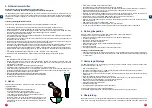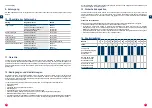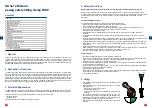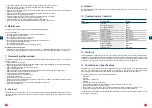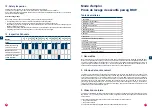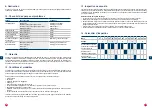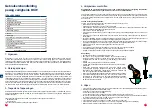
E
E
9
8
Owner’s Manual
pewag safety lifting clamp BKW
Contents
1. General
Thank you for choosing one of our high-quality products. The quality systems of management and services of
pewag austria GmbH fully comply with ISO 9001 standards. The many years of vast experience are a guarantee of
optimum quality and safety. pewag lifting clamps are manufactured from high quality alloy steels and comply fully
with all standards and product requirements including: European standard: EN 13155, Australian standard: 4991, US
standard: ASME B30.20-2010 and Machinery Directive 2006/42/EG.
2. Description of functions
The BKW safety beam lifting clamp has been especially developed for the lifting of steel beams. A special lifting
shackle is used to place the centre of gravity of the beam to be lifted directly beneath the lifting shackle. This maintains
the equilibrium of the beam once it is lifted. The BKW lifting clamp features a safety mechanism consisting of a
locking device, a tension spring and a lever. Once the lever is operated, the safety mechanism provides constant
pretensioning of the cam on the steel plate, thus ensuring that the clamp does not slip when the lifting force is applied.
When a load is being lifted, the clamping force on the cam is increased by the weight of the load. It also ensures that
the clamp will not work itself loose from the plate when the lifting force is off the clamp.
3. Permitted Applications
The BKW lifting clamp may only be used for lifting and transporting steel beams (T, UNP, INP, IPE, HE, etc.), where it is
possible to position the clamp on a flat point of contact so that the clamp completely fits on to the flange of the beam.
Permitted positions for using the clamp are the lifting and transporting of beams from:
• horizontal position
• vertical position
Technical documentation is available from the manufacturer.
4. Safety Instructions
Safety first! Guarantee your personal safety by carefully reading the following safety instructions first.
Ensure your own safety and that of others and continue to benefit from our product safety by having the clamp
inspected, tested and, if necessary, overhauled at least once (1x) a year by pewag austria GmbH or by a recognised
mechanical repair and service centre. See also Chapter – Overhaul. Contact pewag austria GmbH for further
information.
Avoid life-threatening situations
Avoid life-threatening situations by complying with the following guidelines:
• Never work with an untested clamp or clamps with an expired test certificate
• Keep a distance when lifting and never stand under the load
• Do not use the clamp if damaged; have the clamp repaired by pewag austria GmbH immediately or by an
authorised mechanical repair centre. If in doubt, please contact your supplier
• Never lift more than one beam at a time
• Never lift beams that are heavier than the working load limit (WLL), as indicated on the clamp and the test
certificate
• Do not lift beams with flanges thicker or thinner than the jaw opening, as indicated on the clamp and the test
certificate
• When simultaneously operating a number of lifting clamps arranged in a row use lifting slings or chains which are
of sufficient length to ensure that the angle between the slings or chains never exceeds 60°
• When simultaneously operating a number of lifting clamps arranged in parallel, use a lifting beam (equaliser) and
lifting slings or chains of a sufficient length to ensure that the lifting shackles on the clamps are never subjected
to lateral load
• Do not place the clamp on conical sections of the beam to be lifted
• Remove all grease, oil, dirt, corrosion and mill scale from the beam at the point where the clamp is to be attached
• The surface hardness of the beam must not exceed 37 HrC (345 Hb, 1,166 N/mm
2
)
• All clamps are only suitable for use in normal atmospheric conditions
Safety precautions
• Ensure that the lifting shackle can never be subjected to lateral load
• A free fall or uncontrolled swaying at the crane hook resulting in objects being struck may cause damage to the
clamp. If this occurs, check whether the clamp is in good working order before further use
• Lifting clamps are not suitable for creating permanent joints
• The clamp should be subjected to preventive maintenance on a monthly basis in accordance with the guidelines
described in Chapter 6 – Maintenance
• Do not modify the clamp (by welding, grinding, etc.), as this can adversely affect its operation and safety, thereby
nullifying any forms of warranty and product liability
• Use only original pewag components
• Any improper use of the clamp and/or failure to observe any directions and warnings in these safety instructions
concerning the use of this product may endanger the health of
the user and/or bystanders
5. Lifting
• Check whether the working load limit (WLL) of the lifting clamp is
not exceeded.
• Attach the lifting clamp to the hoisting mechanism, by one of the
following means:
- safety shackle directly to a crane hook
- coupling link or D-shackle
- sling or chain, if necessary in conjunction with a coupling link or
D-shackle
• Ensure that all attachments have been tested and are of the
correct tonnage. Make sure that coupling links and shackles are of
sufficient dimensions to allow the clamp to move freely in the hook
• Check whether the clamp shows any visible damage
• Operate the lever to check whether the clamp opens and closes
smoothly
X
Z
T
Y
D
H
U
S
V
R
W
15°
15°
max.
max.
100%
0°
90°
100%
1. General
8
2. Description of functions
8
3. Permitted Applications
8
4. Safety Instructions
9
5. Lifting
9
6. Maintenance
10
7. Disassembling/Assembling
10
8. Overhaul
10
9. Disposal
11
10. Troubleshooter's Checklist
11
11. Warranty
11
12. Conditions and Specifications
11
13. Safety Inspection
12
14. Inspection Schedule
12
Appendix – Safty lifting
22
– Disassembling/Assembling
22



